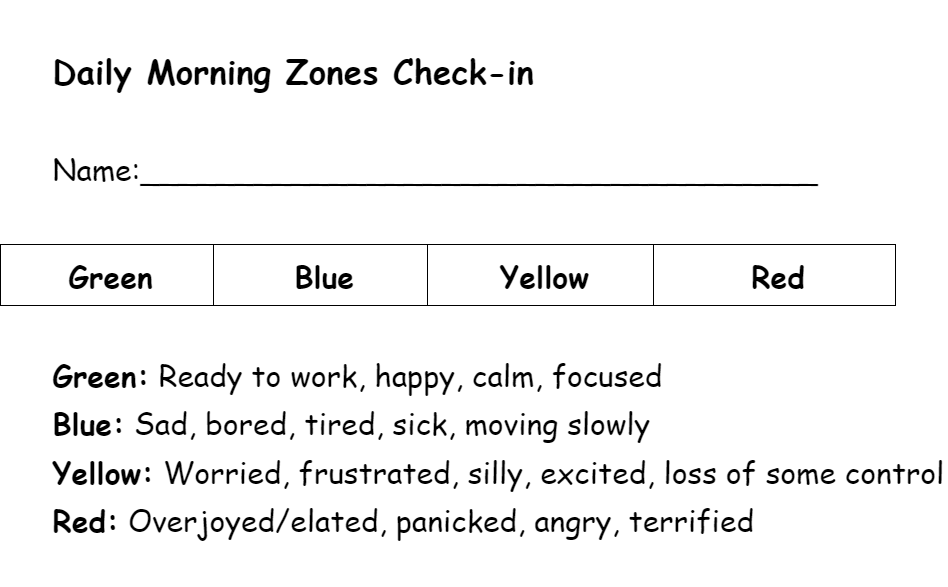Student Contributor: G. Robinett
 Every morning, when students first sit down, they will fill out the “Zones Check-in” Slip. The teacher will collect these slips and will be able to quickly sort through them, in order to gauge exactly how all of their students are feeling, with no interruption or distraction. This will also give the students an opportunity to alert to the teacher that they might not be doing so great and need to talk with the teacher.
Every morning, when students first sit down, they will fill out the “Zones Check-in” Slip. The teacher will collect these slips and will be able to quickly sort through them, in order to gauge exactly how all of their students are feeling, with no interruption or distraction. This will also give the students an opportunity to alert to the teacher that they might not be doing so great and need to talk with the teacher.
This tool is used every morning or before the start of every new class period (for upper-grade levels). The daily check-in sheet is placed on students’ desks by the teacher before students walk into the room. They will quickly assess how they are feeling (Green: Ready to work, happy, calm, focused. Blue: Sad, bored, tired, sick, moving slowly. Yellow: Worried, frustrated, silly, excited, loss of some control. Red: Overjoyed/elated, panicked, angry, terrified). The students will circle the “zone” that best fits how they are feeling. I experienced this tool in a middle school science classroom, where students filled in their zones check-in before class had even begun. The teacher then collected them and moved on to introduce their first set of directions/tasks for the day. Once the students were working independently, the teacher took a few seconds to sort the slips into piles, by zones. She made a mental note of where her students are at, and if they are in the “Red” zone, she made it a point to check in with them, privately. This slip is made for middle school, but using clipart art images for younger/ESL students would work!
This tool best fits in the supportive phase. “Daily Zones Check-in” is in the supportive phase because it gives the students an opportunity to communicate to their teacher what their needs may be, and to allow the teacher to meet those needs. This form of communication also supports students as it can act as a self-reflection for the students, without taking up too much time. This tool best falls in the “collaborative” part of the theories of influence spectrum. This is best for collaborative-based teachers as it gives the teacher an idea of their students' social-emotional needs, and gives them the opportunity to privately check in with their students. This is also pretty quick, and most times does not require a follow-up by the teacher. Not much time is spent completing this activity and is more to make sure that the students are individually on the same page as their teacher.
More Information –
Tool Source: I first saw this used in a science classroom at Chase Middle School, but it stems from The Zones of Regulation™ Social Emotional Learning Curriculum.
https://www.zonesofregulation.com/index.html



I am currently working with second graders in an urban elementary school. This tool was extremely easy to prepare for and implement in the classroom. Passing out the slips after our morning meeting and giving the students a minute or two to complete did not interrupt our day at all. This also seemed to help students transition after our morning meeting. Being able to read these slips each day helped me gauge how students were feeling and why (if they chose to provide a reason). I could use this information throughout the day to see what students may need a little extra support and attention from me as well as prepare myself to help them in any way they might need. I also noticed that it helped me be a little more patient with students when they were getting distracted or struggling to complete their work in the time given when I knew they might not have slept well the night before or had a rough morning before coming to school. The students in my classroom are familiar with the “Zones of Regulation” so they had no problem understanding what was being asked of them and how to complete the slip. Since this wasn’t completely new to them, they were able to use this tool independently after being given instruction the first time it was implemented. I absolutely love this tool and would not change anything about it.